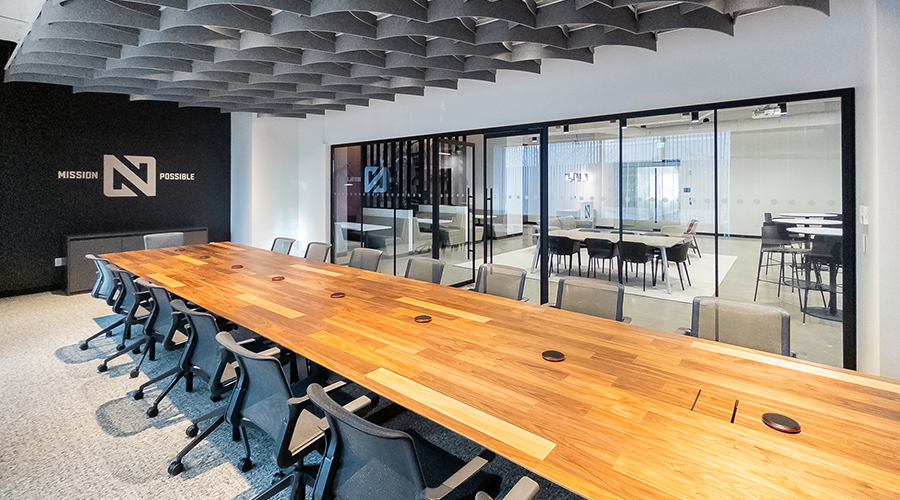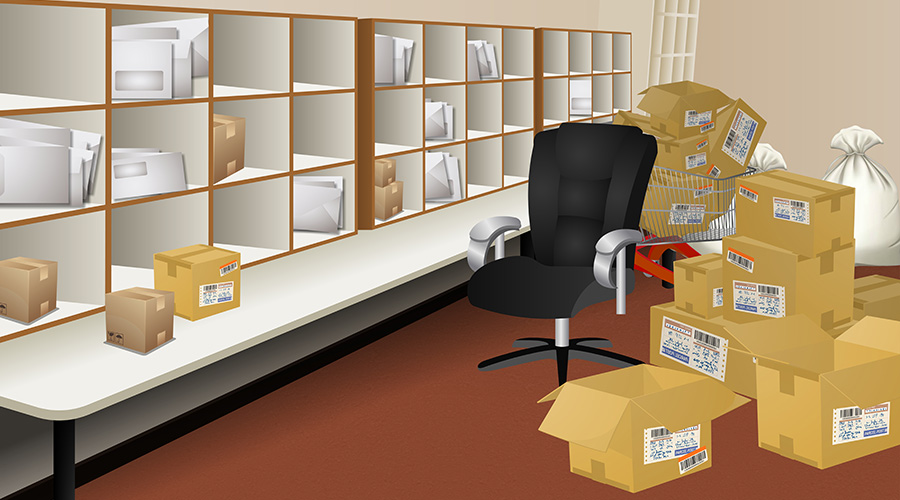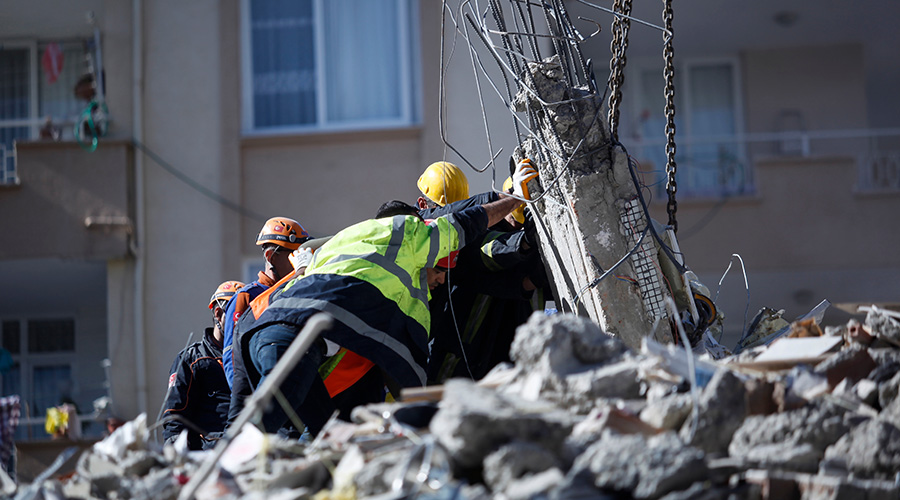No Dogs Allowed
In today's business world, designing for productivity means practical steps to improve speed, efficiency or flexibility — not "fun" measures like letting employees bring pets to work
Remember the late 1990s, when productivity promised to become one of the key criteria for measuring a workplace’s effectiveness? Organizations everywhere tore down walls and cubicles to promote collaboration; installed coffee bars and dry cleaners so employees would never have to leave the building; and a few even opened their doors to golden retrievers — all in the name of bolstering their bottom lines by increasing workers’ productivity.
Just a few years later, a lagging economy forced some serious belt-tightening. All that late-‘90s concern about productivity seemed somehow decadent as many corporations turned their attention to the more mundane business of keeping the place afloat during tough times.
Now that the economy appears to be on the mend, productivity is in the air again. It’s a pendulum’s swing, to be sure. But to hear experts tell it, productivity’s renaissance is not so simple: The lessons learned in the productivity heyday of the 1990s, combined with the perspective afforded by a few years’ cooling-off period, have produced an emerging approach toward workplace productivity that is nuanced, measured and in some cases a little more grown up.
Form follows function
The fact that talk about productivity waned during the economy’s lean years is not too surprising. Nor is the fact that many business leaders prioritized cost-cutting measures — like squeezing more people into crowded floorplans, eliminating investments in systems furniture and trimming technology budgets — over maximizing employees’ productivity. What did surprise some observers, however, was that interest in the issue never really went away.
“Sure, there were a lot of organizations that really took their eye off the ball,” says Steve Hargis, senior vice president, HOK Advance Strategies. “But there were a lot of others who regarded the past few years as a chance to regroup and think about holistic solutions that both save money and support business goals.”
Tom Vecchione, Northeast regional design director and principal, Gensler, says that several broad emerging trends helped keep business leaders focused on productivity, even through the lean times.
“A huge cultural shift began to emerge as younger workers started moving into leadership positions and became a very important workforce to attract and retain,” he says. “At the same time, increased global competition made it all the more important for companies to be efficient and highly productive. So even when the economy was tough, companies had to keep people happy and keep them working effectively. They knew they could only afford to be so conservative.”
What exactly does it mean to keep today’s workers happy and working effectively? The answer, say experts, is different for every organization.
“For one company, it may be about retaining employees by creating a workplace people feel good about,” says Debra Moritz, managing director for strategic consulting, Jones Lang LaSalle. “For another, it may mean reducing the amount of time people spend in their cars driving back and forth to the office. It’s got to be defined differently for every company and its particular culture.”
Across the board, however, maximizing productivity boils down to the creation of a workplace that helps employees advance core business goals. In today’s environment, speed, efficiency and flexibility are key objectives for nearly every organization. Achieving those goals begins with a hard look at how, when and where employees really work. This process, experts predict, will reveal that some of the workplace trends of the 1990s have weathered the economic downturn.
“Even just a few years ago, the mobile worker was seen as the exception rather than the norm. But now we’ve got major corporations whose downtown headquarters buildings are 60 percent vacant because everybody is somewhere else,” says Jon Ryburg, president of Facility Performance Group. “This change is for real. Those workers are not coming back to the headquarters.”
Additionally, says HOK’s Hargis, employees who are not actually off-site are still away from their workstations a good part of the time — in meetings, on teleconferences or in collaborative sessions with co-workers.
“People are really in their cubes or offices less than 50 percent of the time,” Hargis says. “The focus now is going to be on the other 50 percent. Let’s talk about supporting people in all the places they really work.”
Technology that enables employees to connect to others and access data from virtually anywhere — a conference room, home, a satellite office, a client’s site, a lab, a car, an airport or Starbucks — therefore plays a key role in today’s productivity initiatives. At the same time, creating workspaces that provide effective operational bases for this increasingly mobile workforce — in all its myriad forms — is quickly emerging as the central challenge for facility executives interested in productivity.
Re-envisioning space
Facility executives facing the challenge of creating productive workplaces are finding solutions, in part, through a nuanced approach to allocating space. Increasingly, this means de-prioritizing dedicated, individual space in favor of creating more collaborative space or workstations that can be shared by employees.
“In the late ’80s and ’90s, the ratio of shared space to dedicated space was 1:10,” says Ryburg. “Now we see that absolutely shifting around. The emerging ratio is 10:1.”
“Companies are really drilling down into the utilization of space and realizing that there can be an overlay of usage,” adds Hargis. “Sharing usage provides tremendous opportunities to give people more resources and bring down the square footage that is dedicated to each employee.”
Approaches like this are supported by technology that allows employees to connect to their own voicemail or network folders from any workstation, for example.
“It’s all about helping everyone be more productive by more effectively using a space that someone is currently sitting in only three or 10 or 20 hours a week,” says Jones Lang LaSalle’s Moritz.
Experts caution against simply crunching too many employees into too little space — a move that is decidedly not conducive to optimal productivity — and advise against reducing workstations size to less than about 175 square feet. By and large, however, the universal standards that guided space planning in the 1990s have given way to an approach that emphasizes flexibility over uniformity.
“Most of the printed guidelines are staying on the shelf, and the old benchmarks aren’t working very well,” says Ryburg. “The push is toward developing standards that can be used for a long period of time despite the rapid rate of change in the business world in general.”
A workstation that is small by traditional standards, for instance, may be perfectly functional if the furniture can be rolled out of the way, if the computer table collapses when the occupant’s laptop is not in use, or if creative storage options help make the most of existing floor space. It may, in fact, be better than a larger but less well-designed workstation in terms of supporting productivity.
Productivity gains come in by accelerating communication, Vecchione says. “It’s important to think about how easily people can collaborate and share ideas with others, as well as issues like radius of view and distance of reach.”
Also helpful in creating a flexible workplace that truly supports employees’ diverse needs: furniture that allows workers to open a closed space, perhaps by removing walls between adjacent stations, or to create privacy in an open environment.
“If you look at the history of alternative work environments, it’s mostly been talk about collaboration and getting people together,” says Hargis. “But there’s a lot more balance about that now. The goal is to support people in all the modes of work they do, and concentrated work is also important. Sometimes it’s important for things to be private and secure and closed.”
Coming full circle
Experts who specialize in helping companies enhance productivity report being pleasantly surprised at the open-mindedness with which many top-level decision-makers approach the issue today. Executives are more willing than in the past to consider creative solutions and even radical departures from ingrained ways of operating. It’s a subtle but important shift in mindset, and one that would not have been possible without the nearly decade-long cycle that has brought the productivity conversation where it is today.
“We really needed that 10-year model for companies to come to all of this so easily now,” says Vecchione.
The passage of time has also mellowed the productivity movement a bit, and some of its more flamboyant elements have essentially faded away. For instance, today’s productivity efforts focus on helping employees work, not on providing them with ways to play. Productivity measures being implemented now reflect the realization that most people don’t actually want to live at the office — they want flexible work lives that allow them to balance their professional and private priorities. As a result, newer office designs incorporate fewer on-site amenities, emphasizing instead accessible locations and the provision of resources for nontraditional work arrangements. Foosball tables are giving way to banks of hoteling workstations, and coffee bars are designed not as places to break from work, but as alternative work areas where employees can plug in their laptops or hold an informal meeting.
“In the ’90s, there was all this focus on the new workforce. The workplace needed to be more ‘fun’ in order to attract these younger workers,” says Vecchione. “This breathed a lot of fresh ideas into the workplace and it changed the office model forever. But the strategies weren’t necessarily well thought-out. It wasn’t necessarily a mature change.”
“You’re not going to see that can-I-bring-my-dog-to-work attitude,” says Tim Springer, president, HERO, Inc.
In addition, facility executives have learned the danger of misunderstanding or misapplying concepts that were intended, first and foremost, to enhance productivity.
For example, says Springer, “hoteling was sold as a way to save on real estate. That really misses much of the value to the organization and all of the value to the employee. I think that going forward people will have a more well-rounded attitude about strategies like that.”
In addition, Jones Lang LaSalle’s Mortiz notes that rather than regarding productivity enhancements as solutions that can be cut and pasted into an existing culture, today’s organizations are learning to regard productivity as one part of a comprehensive organizational metric.
“You’ve got to look at it as one part of an integrated approach to supporting business goals,” Mortiz explains. “Unless you approach it from that perspective, the steps you take to improve productivity are never going to be as effective as they could be.”
The measurement of the impacts of productivity enhancements — long a hotly debated issue — has also evolved. A discussion of productivity today is likely to focus on both qualitative factors — like whether employees report being happy with their workplace — and quantitative factors, like the number of new ideas generated by a given team over a given period of time. It’s a far more measured approach, says Hargis, than the late-’90s attempt to quantify productivity through keystrokes per minute or other rigid measures.
“We’ve matured a lot around the kinds of space that support people and make them more productive, and we’ve grown in confidence that these things really do make a difference,” says Hargis. “We’re not looking for the perfect solution anymore because we’ve realized it doesn’t exist. Things are going to change at a rate we can’t predict and that is going to change the way we do business and the things our employees need to be productive. All we can do is stay as agile as possible. That’s where the productivity discussion is focused now.”
Abigail Gray, a contributing editor for Building Operating Management, is a writer who specializes in facility issues. She is the former editor of EducationFM magazine.
Related Topics:











